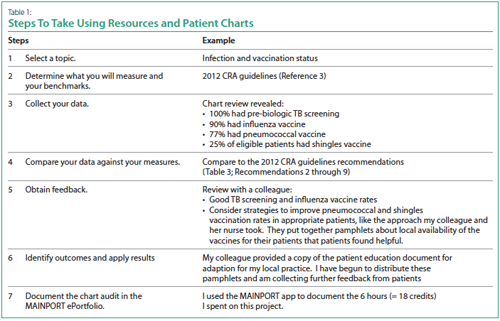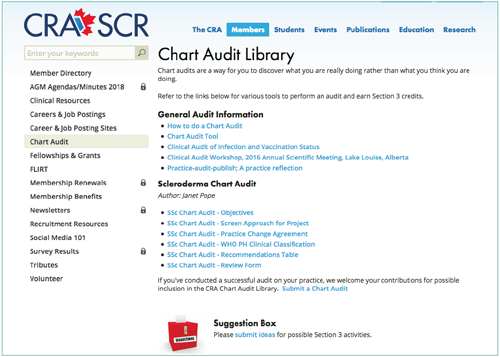Spring 2018 (Volume 28, Number 1)
CPD for the Busy Rheumatologist
Practice Reflection: Can I Improve My Patient Outcomes with MOC Section 3 Credits?
By Raheem B. Kherani, BSc (Pharm), MD, FRCPC, MHPE; Jerry M. Maniate, MD, M.Ed, FRCPC; and Craig M. Campbell, MD, FRCPC
Download PDF
I recently finished my review and reflection on my Continuing Professional Development (CPD) activities,” exclaimed Dr. AKI Joint, a rheumatologist member of the CRA. “I realized that I don’t have much in section 3, despite all of my CPD activities for last year. I faithfully reviewed the Summer and Fall 2017 CRAJ CPD articles. I went to rounds and the 2017 CRA Annual Scientific Meeting (ASM) in Ottawa for maintenance of certification (MOC) section 1 credits. After reading the last article, I downloaded the MAINPORT app for iPhone and Android users (www.royalcollege.ca/rcsite/resources/access-royal-college-apps-e) which enabled me to capture MOC section 2 credits, in real time, for the learning I was already doing while looking after my patients.”
“I read on The Royal College of Physicians and Surgeons of Canada (RCPSC) website that all new MOC program cycles beginning on or after January 1, 2014, require program participants to complete a minimum of 25 credits in each section during their five-year cycle. That means I need to complete MOC section 3 credits, too. I have never done this before.”
“Interestingly, the Royal College website states, ‘The CPD research literature1,2 has clearly demonstrated that physician’s self-assessment compared to external measures of performance is inaccurate, and assessment strategies that provide data with feedback have a higher likelihood of changing performance and improving patient outcomes compared to other forms of continuing professional development.’ Even though I am a busy clinician, I certainly want to improve my practice and do an even better job looking after my patients. This sounds like an approach that really could work. I do look after many patients with rheumatoid arthritis that require assessment of tuberculosis (TB) and vaccination status,” reported Dr. Joint. “I think I am consistently assessing these aspects of care before commencing treatment, but how would I know for sure?”
“The Royal College website had a number of potential ideas for Performance Assessment, including multi-source feedback, feedback on teaching and direct observation. I certainly used the first two in training. I remember a poster at the 2017 CRA ASM about video review (Abstract 201 [page 81] in The Journal of Rheumatology [jrheum.org/content/jrheum/early/2017/04/22/jrheum.170256.full.pdf], that was discussed further in an MOC Tip of the Month in the RCPSC Dialogue) (royalcollege.ca/rcsite/publications/dialogue/dialogue-july-2017-e). However, the approach that seems like it will work for me is a Chart Audit. At the 2016 CRA ASM in Lake Louise, some of my colleagues went to a Chart Audit Workshop by Dr. Henry Averns and learned about how to analyze their patient medical records to improve the quality of their patient care. On the CRA website members’ section (Figure 1) there was great information from this workshop (rheum.ca/en/members/chart_audit). This was really useful! I also found step-by-step instructions on ‘How to do a Chart Audit’, links to Chart Audit tools and examples of Clinical Audits of Infection and Vaccination Status and Scleroderma. There is even a link to a fellow CRA member’s article on publication of practice audits (ncbi.nlm.nih.gov/pmc/articles/PMC5283566/).”
“Using the above resources and my patient charts (either paper or EMR) I tried the steps outlined in Table 1." “Since I have been following the series on CPD for the busy rheumatologist, I have an advanced understanding of MOC sections 1, 2 and 3. As a result, I am now more precise with my choice of learning opportunities, I am able to document my patient-based learning on the MAINPORT app, in real time, and also improve my practice and care for my patients through chart audits,” reflected Dr. Joint. I plan to review similar data next year to see if my analysis changes for the better. Hopefully, my colleague will review this again and we can learn from each other. At the recent 2018 CRA ASM in Vancouver, there were many interesting sessions, such as immunotherapy, using digital technology in arthritis care, cybersecurity, building cultural competence, and even navigating conflict of interest. Hopefully I can build on what I learned in 2017 to continue to improve my skills as a rheumatologist.”

Before you started reading this series, you might have raised a question on how to make your learning more effective. Reading these articles, the time you spent reading and reflecting on these articles and coming to some conclusions on results that you would like to implement, would qualify for a Personal Learning Project (MOC section 2).
Our lives as rheumatologists are busy with the balance of many competing personal and professional interests. Optimizing learning, implementing helpful tools and reflecting on practice, like Dr. AKI Joint did, can make learning more efficient and enjoyable while also impacting our ability to provide care!
If you have your own CPD stories or tips to share, please email Claire McGowan at claire@rheum.ca.
Acknowledgement to Dr. Barry Koehler (a CRA Past-President), for the initial discussion that lead to this article series, immediately following the 2017 CRA Annual Scientific Meeting (ASM).

Figure 1. CRA website, members' section
Raheem B. Kherani, BSc (Pharm), MD, FRCPC, MHPE
CRA Education Committee Chair
Clinical Associate Professor, University of British Columbia
Medical Lead, Arthritis Program, GF Strong Rehabilitation Centre
Vancouver, BC
Rheumatologist, West Coast Rheumatology Associates
Richmond, BC
Jerry M. Maniate, MD, M.Ed, FRCPC
Vice President of Education,
The Ottawa Hospital
Assistant Professor of Medicine,
University of Ottawa
Ottawa, ON
Craig M. Campbell, MD, FRCPC
Director, Continuing Professional Development,
The Royal College of Physicians and Surgeons of Canada
Ottawa, ON
References:
1. Davis DA, Mazmanian PE, Fordis, et al. Accuracy of physician self-assessment compared with observed measures of competence: a systematic review. JAMA. 2006; 296(9):1094–02. doi:10.1001/jama.296.9.1094
2. Eva, K. W. and Regehr, G. “I'll never play professional football” and other fallacies of self-assessment. J Contin Educ Health Prof 2008; 28: 14–9. doi:10.1002/chp.150
3. Bombardier, C, Hazlewood, GS., Akhavan, P, et al. Canadian rheumatology association recommendations for the pharmacological management of rheumatoid arthritis with traditional and biologic disease- modifying antirheumatic drugs: Part II safety. J Rheumatol 2012; 39(8):1583-602.
|




